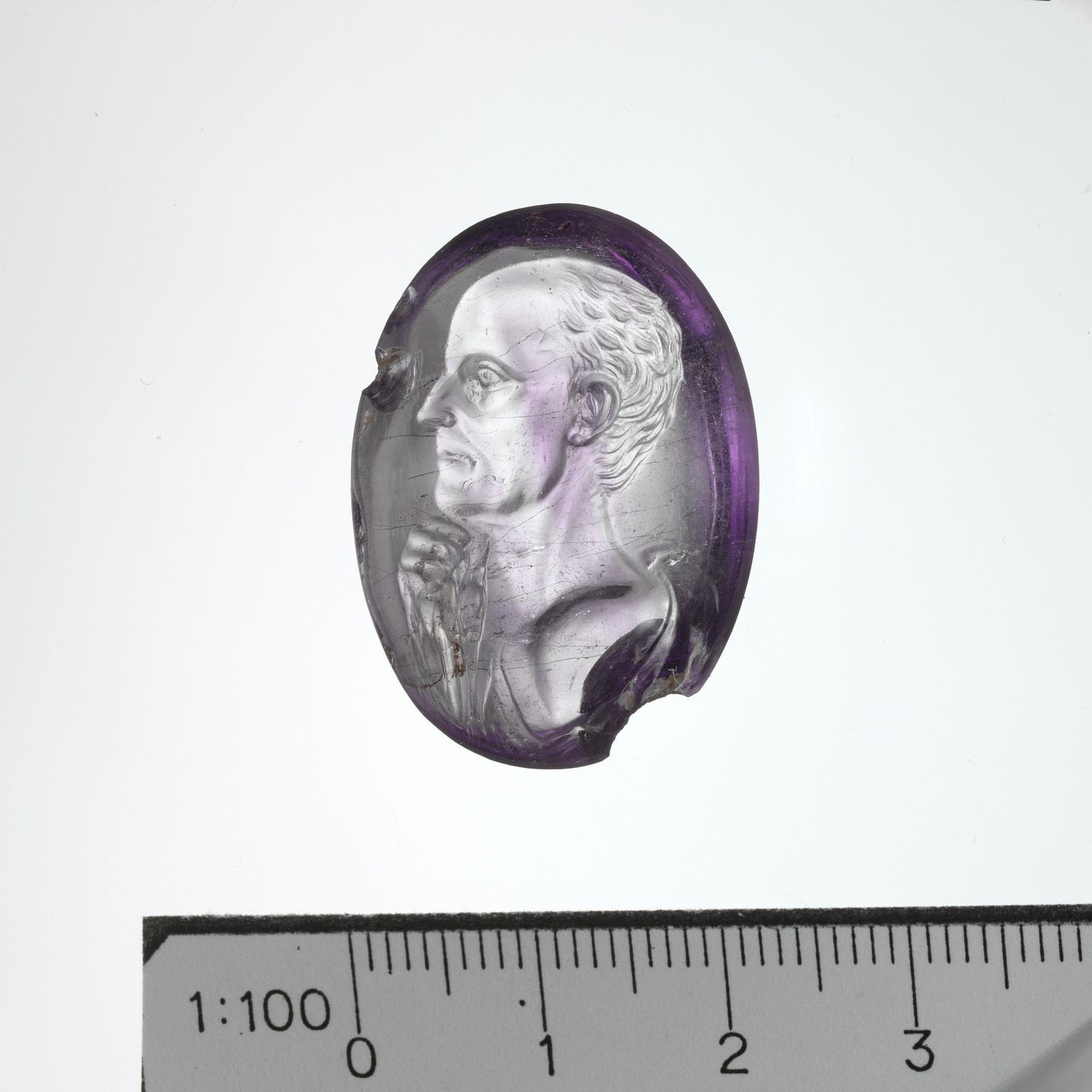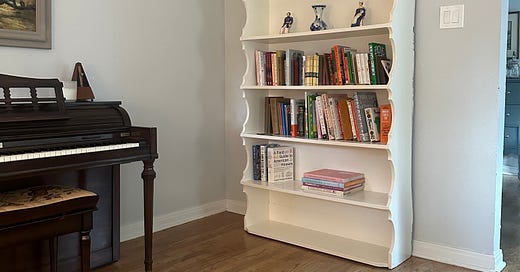Is there enough enrichment in my enclosure?
Creating a home that inspires you and fuels your curiosity, plus a deep-dive into a really beautiful form of ancient art, and my favorite curtains.
GETTING BACK TO LEARNING
Is there enough enrichment in my enclosure?
Over the weekend, I acquired a bookshelf. It was in my childhood bedroom, which is now my younger sister’s room, and she no longer wanted it—so I took it, painted it, and propped it against the wall in my living room. I haven’t had a proper bookshelf in a while and my novels, journals, cookbooks, and collections of design and art books have been scattered around the house (some woefully neglected in drawers).
I have a good number of books, but not enough to fill six shelves. I’ll have to add to my collection (lucky me). Over the weekend, I made a list of all of the books I want to acquire copies of—old copies, new copies, beautiful copies, etc. It’s mostly classic literature, much of which I read during school (like Dante’s “Divine Comedy” and Augustine’s “City of God.”
One of the things I miss most about being a child and young adult is all of the time you get to set aside for learning. Sure, when you’re an adult you learn new skills at work or at home, or you teach yourself new things. But it’s not the same. Learning is not the end goal; it’s a means to the end. It’s transactional. You must learn a specific skill to achieve a specific outcome.
But in the last few months, I’ve been exploring creativity (spurred on by the book “The Artist’s Way,” which I have been working through and highly recommend). It’s caused me to be a little more attentive to the things that delight me, entertain me, and enrich my life. I’ve mentioned before how I’ve found a renewed love for classical music and old films. It’s the same with old books, especially the ones that shaped me when I was a child and learning how to be a person. When I hear the music or open the book, I feel peace and excitement simultaneously. It’s a stark contrast to the survival-mode feelings I’ve had in the last few years (and perhaps you’ve had them too, given … everything).
There’s this joke that’s been circulating the internet for a while now about “having enrichment time in my enclosure.” The joke likens people to zoo animals: We need opportunities for enrichment so that we stay engaged with our lives. In short, it’s important to do the things we love in a safe space. Your home (or enclosure) is an important part of the equation.
When decorating or creating a home, I think we look to utility and aesthetics above all else. We need our homes to be functional, so we count bedrooms, organize cabinets, and buy multi-functional furniture pieces. We’d like our homes to be beautiful, so we seek to replicate the ones we see in images and films. These are guideposts used to make decisions about home design and decor. And they work!
But homes are becoming more and more homogenous, and it has a negative effect. Recent research found that the “shift toward standardization” in homes is making people uneasy, unsettled, and unhappy. People are afraid to make the wrong decisions in design or find out down the line that they’ve adopted a trend that soon went out of fashion. It’s stifling.
If the home was viewed as a space for enrichment, though, that could change. Some of us already do this, naturally, and in small ways. Meet a reader or a writer and it’s a guarantee that they have a pile of books stacked somewhere in their home—and they feel immense pride when they see you looking through their collection. A chef has a kitchen outfitted with essential tools or fresh produce. A musician has instruments on display.
I think we need to take that enrichment a step further, beyond acquiring tools for creativity. Filling a home with items that inspire and delight, however silly or cluttered they may be, can have an enriching effect and even convey a sense of peace or restfulness. It’s an opportunity to be connected to the interests that make you uniquely you.
In putting together my bookshelf, I found a few books that once belonged to my great-grandmother and my great-great-grandmother. There were notes in the margins and names and dates written on the cover pages. A few of the books were on my list of items to collect (Cicero’s orations and some of Shakespeare's plays). I thought how sweet it was to see that some things—art, literature, music—have enduring, enriching value across generations. Connecting with those things that delight me, the things that fuel my creativity and inspire me, makes me feel connected and engaged with life too. Like there’s more beyond my workday, beyond my screen, beyond my tasks, beyond my troubles or questions. There’s a whole lot more.
BEAUTIFUL, TINY ART PIECES THAT INSPIRE ME
Some history about intaglios and cameos, my latest decor fascination
This weekend, I went down a rabbit hole researching intaglios and cameos. It was spurred on by my recurring perusal of this collection of intaglio reliefs from British brand Pentreath and Hall, which I frequently peruse with plans to purchase one day. But I’ve seen an abundance of intaglios and cameos in decor in the last year or so. Usually, they’re framed simply and set against a contrasting background, and they’re often grouped in a collection.
Intaglios have been around forever (more on that in a second) and they have been featured in design and fashion for years, so it’s no surprise that there’s a resurgence in popularity. Remember the episode of “Friends” where Rachel finds out that Ross is in love with her because he buys her an expensive brooch for her birthday? It’s a cameo. See? Classic.
The difference between an intaglio and a cameo is that an intaglio is carved into a material, a recessed image, while a cameo protrudes from the material it was carved from. Intaglios are used to make casts, or plaster reliefs, that have the image raised above a solid, often-colored background.

Cameos and intaglios have had huge cultural significance for thousands of years. For prominent members of society in the Roman Empire, intaglios were used as wax seals with personalized images carved into gemstones.1 The artwork depicted famous figures, like emperors (above) and mythological characters (below).

Generations later, intaglios and cameos resurfaced as collectible items during the 18th century.2 Collections of intaglios were acquired during those great European expeditions taken by the young and affluent in that century, when they traveled from London to Paris and, most importantly, to Italy. In Rome, ancient intaglios were readily available as souvenirs.3 As a more affordable alternative, vendors made plaster casts (or impressions) from intaglios. These are often found in collections that were brought back from Grand Tours, like the ones below.

But if this art looks familiar to you still, and you can’t pinpoint it: maybe you’re thinking of Wedgwood ceramics, made popular also in the 18th century. Cameo designs on pottery depicted similar ancient scenes and continue to be in high demand today. One detail that surprised me: Josiah Wedgwood I, and the Wedgwood ceramics company, issued a cameo medallion design that was used as an emblem of the antislavery movement across Britain, France, and the United States.4

As far as design goes, I’d love to hang one of artist Bridie Hall’s Grand Tour intaglio sets in my living room—I like this blue one. But I had another idea this weekend too, an homage to my love of classic literature and philosophy: what about a collection of these intaglio plaques (also by Bridie Hall) beside my bookcase? I’d pick Dante Alighieri, William Shakespeare, and Michelangelo.
Here are a few other sources too:
More framed intaglios, this time atop marbled paper, from Parvum Opus.
A massive set of Grand Tour intaglios. (Could anyone lend me $4,000? ;)
All sorts of intaglios that you could frame yourself if you were feeling artsy. (There are plenty of tutorials online.)
And for fun, intaglio soaps.
GOOD CHOICE: CURTAINS (AND THREADS)
Affordable curtains and more home recommendations
A college friend of mine put a note out on Instagram’s new platform, Threads, for some decor advice last week: insulating curtains that aren’t ugly.
My response was this: Pottery Barn’s Broadway Curtains.
They come in multiple widths and lengths, and you can buy them with blackout lining (which is insulating) or without. The colors are simple; I have them in ivory in my bedroom and plan to buy more. Plus, they go on sale frequently and they are priced as a set of two—a rarity in the oddly expensive search for decent curtains.
A curtain-hanging tip
It’s better to get a too-long curtain and hem it (or let it pool at the bottom a little) than one that’s too short. My ceilings are eight feet tall and I bought 96-inch curtain panels and hemmed them. Hang the curtain rod as high as you possibly can and about six to eight inches wider than the window frame, to make the ceiling look taller and the window look bigger.
And, last thing: Have you joined Threads? I’m still learning the platform but I’ve decided that I want to use it to share decor recommendations, so tag me in a thread if you’re looking for something and are stuck. You can find me here. If you haven’t joined or don’t want to, feel free to tell me what you’re looking for in the comments here on Substack and I’ll reply.
NEXT WEEK
Save or spend? How to know what to invest in (and where to find it).
I think the best homes are the ones with a mix of high and low items. They’re beautiful and not fussy, but there’s longevity to them—especially when you can see that someone’s taken the time to choose a piece (art, furniture, fixtures) that they’ll keep for a long time.
On the flip side, while some dupes and DIYs are helpful, they don’t always last. It’s hard to know where to spend (and what to spend it on) and how you can save.
Next week, I’ll pull together some product recommendations and decor shops to peruse for when you want to save and when you want to spend. We’ll also touch on how to make a home comfortable, the decor elements that can have the most impact, and how to make a home comfortable over time.
All the best,
Mary Grace
https://www.sothebys.com/en/articles/the-a-z-of-jewelry-i-is-for-intaglio
https://www.sothebys.com/en/articles/the-a-z-of-jewelry-i-is-for-intaglio
https://www.jstor.org/stable/41377239
https://www.vam.ac.uk/articles/wedgwood-an-introduction





